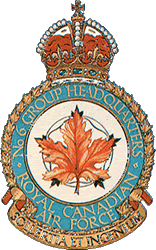
100 Halifaxes from 408, 415, 420, 425, 426, and 432 Squadrons were ordered on an attack at Gladbeck. The crews were over the target at between 16,000 and 18,000 feet, releasing 772,000 lbs of high explosives. According to reports, the attack was accurate and severe damage was done.
![]()
F/O F. Reain from 408 Squadron returned early as the port inner was u/s. They landed safely at base on 3 engines.
![]()
P/O J. McKenzie from 415 Squadron returned early as the hydraulics were
u/s and both inner engines were over heating. They landed safely at base
on 3 engines.
F/O J. Patterson was hit by flak, there were holes in both wings, the
fuselage and in the tail.
![]()
F/O N. Toderan from 420 Squadron returned early as the port outer was
u/s. They landed safely at base on 3 engines.
F/O D. Gordon was hit by flak, not serious.
![]()
P/O S. Allen from 432 Squadron returned early as the stbd outer was
u/s. They landed safely at base on 3 engines.
F/O R. Martindale and F/O S. Raymond were hit by flak, not serious.
![]()
While the Halifaxes went to Gladbeck 75 Lancasters from 419, 424, 427, 428, 431, 433, and 434 Squadrons were ordered to attack the Mathias Stinnes oil plant at Bottrop. The crews were over the target at between 14,000 and 18,000 feet, releasing 937,000 lbs of high explosives.
![]()
F/Lt P. Tulk, F/O G. Retallack, S/Ldr D. Hunter, S/Ldr G. McMurtrie, and F/O R. Chambers from 419 Squadron were hit by flak, not serious.
![]()
F/O J. Stuart from 424 Squadron was hit by flak, the port inner, outer and stbd inner were damaged. Both port engines were feathered and a safe landing was made at base.
![]()
F/Lt A. Lock from 427 Squadron was hit by flak, there were holes in the fuselage and port wing.
![]()
F/Sgt D. Deseraux from 428 Squadron was hit by flak, there were holes
in the stbd wing.
W/Cdr W. Gall was hit by flak, there were holes in the stbd wing and
fuel tanks.
![]()
P/O B. Jensen from 433 Squadron was hit by flak, the port and stbd inner
engines were hit, brakes, compasses, and mid upper and front turrets were
u/s. Both inner engines were feathered after they caught fire. The wireless
operator and mid upper gunner fought the fires inside the fuselage till
they were put out. The flaps and under carriage were lowered by the emergency
air system and a safe landing was made at the first available airfield
in Belgium.
![]()